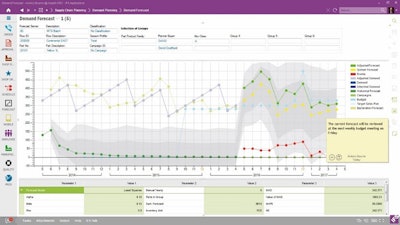
Fierce competition, razor-thin profit margins, perishable products and government regulations define the food and beverage market — and the slightest change can have huge bottom-line effects. Mike Lorbiecki, Vice President Sales, North America at IFS, looks at new developments in demand planning and identifies the three key areas where intelligent demand planning is helping companies get ahead.
Food and beverage manufacturers are under pressure to place the right product at the right place at the right time, and in the right quantity. Companies look to their demand planning to provide them with the relevant data and, while many businesses are already using demand planning, they are not using it as effectively as they could be.
Traditional ERP systems separate each of the different steps in the supply chain, which means that providing full visibility of the entire business operation isn’t always achievable. More agile ERP solutions can provide a full view so supply chains can be harnessed holistically. With this level of visibility across the entire business, intelligent demand planning makes it possible to conduct strategic forecasting to streamline ordering, inventory and production, as well as providing the opportunity to capitalize on additional sales by mapping and then acting on historical data.
Taking a proactive approach to address the future of the food and beverage supply chain results in fewer surprises, shortages or unnecessary spending. There are three key areas where I see ERP with demand planning functionality providing a competitive edge in the food and beverage industry.
1. Staying Ahead Of Seasonal Fluctuations
Seasonality is one of the most used statistical patterns to improve accuracy of demand forecasting. Businesses in the food and beverage industry must always be prepared for change, especially since they operate in a sector where seasonal peaks and troughs across product ranges is commonplace.
Seasonality can impact sales and inventory, so using historical data to make predictions on stock levels and expected sales can provide a much more accurate picture going forward. However, making the best use of all historical data requires a reliable, flexible and easy-to-use business tool.

ERP software with demand planning built-in will help minimize the time-consuming job of defining seasonal profiles, and combines seasonality with sales distribution for visual representation of an organization’s monthly forecast. Demand forecast functionality can even demonstrate historical forecast, system forecast, adjusted forecast, events and campaigns.
2. A Holistic View Means You Can Use Inheritance Data From Other Products
Too many companies don’t give demand planning and forecasting the recognition it deserves, instead choosing to rely on an educated guess. But in the modern business landscape, there is no room for mistakes when it comes to the supply chain.
By understanding trends and being able to accurately predict them, a business can find ways to reduce the impact of high-cost areas such as unnecessarily large inventories, a difficult to manage product portfolio or variable levels of service.
No Historical Data? Yes You Have!
Demand planning functionality should have the capability to populate historical data to provide for an accurate forecast. But if, for example, a cereal manufacturer produces a new breakfast bar and does not have the relevant historical data for the new product, the demand planning functionality needs to be able to provide inheritance data by selecting and grouping historical data from similar products with similar patterns such as seasonal sales or expiration dates. Modern ERP systems can do just this.
Spot The “Cannibal”
Demand planning within an ERP system should also warn management of potential product “cannibalism” (i.e. eating up market share of an existing product by introducing a new one) which can have a negative impact on a company’s bottom line. For instance, a business which produces milk chocolate may suddenly choose to expand into dark chocolate. New graphical, interactive demand planning tools can provide users with widespread forecasting over various timeframes and events and demonstrate potential product “cannibalism” before it occurs. In this instance, the software would alert decision-makers that the new dark chocolate candy has the potential to impact milk chocolate market share.
Without the level of tracking and analysis provided by intelligent demand planning, it is impossible to know for sure whether “cannibalism” may take place, and to what extent.
3. Optimize Forecasting With Collaboration
In most organizations, multiple decision-makers are involved in forecasting decisions, so make sure your ERP demand planning application provides that vital collaboration ability.
Once a forecast has been generated, there is often a need for input from other departments, so the ERP system needs to be able to provide clear data in graphical representations for other users to review and make informed judgements. This way, different users can work simultaneously on selected parts of a forecast while providing valuable input on future sales without disturbing other parts of the forecast.
This collaboration also allows for users to change forecast models to see how events and campaigns will impact sales and the supply chain. If a forecast shows that September sales will be low, a user can add a campaign or event to preview its impact in the forecast. Based on the impacts of the forecast, a user and their colleagues can clearly pinpoint areas that need to be restructured for greater profitability.
Fail To Plan, Plan To Fail
Demand planning is the key to a profit-driven food and beverage supply chain. By harnessing real-time supply chain data, organizations can plan for future demand and seasonality, anticipate cannibal products and engage in collaboration for improved decision-making across the entire enterprise.
Implementing intelligent demand planning functionality as part of an ERP solution that has a full view of the entire supply chain means businesses can expect improved customer service levels, increased sales and reduced inventory carrying costs, while remaining one step ahead of competitors in a market prone to fluctuation.























